The Ultimate Guide To Bobber Fishing (With Pictures)
UPDATED 03 NOVEMBER 2023
by Robert Ceran
Bobber fishing has been widely used for hundreds of years and is still one of the most popular angling methods today.
This makes perfect sense, given that it’s hard to beat bobbers when it comes to catching suspended fish over weed beds (or other types of dense bottom cover) that can snag your terminal tackle in a heartbeat.
In this article we’ll cover the essentials of bobbers, and how to use them effectively, including setup, rigs, and the best techniques for catching fish successfully with bobbers.
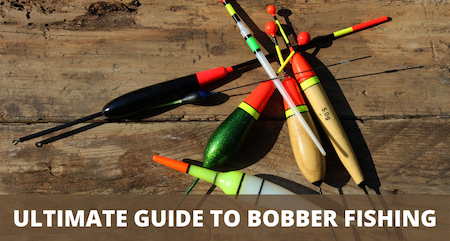
Ready to learn how to put more fish in the boat with bobbers?
Read on below!
What is bobber fishing?
Bobber fishing is an angling technique using a bobber, cork, or similar floating device to suspend your hook at a defined depth in the water column, and is ideal for targeting suspended fish.
By changing the length of line between your bobber and the hook, you can easily adjust the depth at which your hook is presented in the water, which makes bobbers one of the most versatile angling tools available.
Due to this versatility, they can be used to target almost any kind of freshwater fish (as well as many saltwater species).
What does a fishing bobber do?
A bobber has two main functions:
- It suspends your hook at a specific depth in the water column.
- It functions as a bite indicator when a fish takes your bait.
Bobbers are usually made of cork, balsa wood, plastic, or foam, and are designed to float on the water surface, while dangling your hook in the water underneath them.
The exact depth at which your hook is presented depends on the length of line between the bobber and the hook, which can be easily adjusted.
The second function of a fishing bobber is to alert you to fish bites, by acting as a visual bite indicator. In other words, when the bobber goes down, you know that a fish has taken the bait, and that you need to set the hook.
And while this is the basic principle, sometimes bites can be more subtle, and require more finesse skills from the angler in order to detect them accurately.
Fishing bobber types (and how to use them)
| Bobber type | Image | Recommended water depth | Ideal casting distance | Recommended application | Recommended target species |
|---|---|---|---|---|---|
| Round fixed bobber |  | 2 to 4 feet | Short | Fishing for aggressive fish with natural bait | Trout, Crappie |
| Cigar float |  | 3 to 30 feet | Long | Fishing with natural bait or artificial lures (jigs, spoons, spinners) | Walleye, Bass, Steelhead, Salmon, Pike, Catfish |
| Pencil float |  | 2 to 6 feet | Intermediate | Ultra light fishing for shy fish with natural bait or artificial lures (jigs) | Trout, Crappie, Bluegill, Yellow Perch, Panfish |
| Bubble float |  | 2 to 4 feet | Short | Stealth fishing with natural bait or artificial lures (jigs or flies) | Trout or Panfish |
| Waggler float |  | 3 to 20 feet | Intermediate | Finesse fishing for shy fish with natural bait or artificial lures (jigs) | Trout, Crappie, Bluegill, Yellow Perch, Panfish |
| Oval float |  | 3 to 20 feet | Long | Fishing for large, aggressive fish with natural bait or live bait | Walleye, Steelhead, Salmon, Pike, Catfish |
| Oval stick float |  | 3 to 15 feet | Intermediate | Fishing with natural bait or artificial lures (jigs, spoons) | Trout, Bass, Crappie |
| Stick float |  | 3 to 15 feet | Intermediate | Finesse fishing for shy fish with natural bait or artificial lures (jigs) | Trout, Crappie, Bluegill, Yellow Perch, Panfish |
The table above shows the most important types of fishing bobbers, and the techniques and fish species each bobber is ideally suited for.
Since bobbers come in such a wide variety of shapes, sizes and colors, it can be daunting for beginners to make sense of all these different bobbers to choose from.
However, while their differences do matter, you mainly need to get a sense of what each bobber shape and size is good for, so you can choose the right bobber for your purposes.
Also, keep in mind that most bobbers are available as either fixed bobbers or slip bobbers (more on that a few paragraphs further down).
Bobber vs float – what’s the difference?
While the terms ‘bobber’ and ‘float’ are often used interchangeably, some anglers argue that there is a technical difference between them.
Floats were originally designed by European anglers, and are usually long and slim, while bobbers were designed by North American anglers, and tend to be shorter and more round.
However, in this article we’ll use the terms ‘bobber’ and ‘float’ as synonyms, since they both come in many different shapes that basically overlap with each other, and the main thing you need to pay attention to is what shape and size is best for your particular purpose.
Slip bobber vs fixed bobber
Most bobbers come in two basic variations: fixed bobbers and slip bobbers.
Fixed bobbers have metal springs or rubber rings that are used to attach them to the fishing line at a fixed position.
The most common of these are spring floats, which are easy to clip on to your line and stay at a fixed position.
Slip bobbers on the other hand, have a hollow tube that runs down the middle of the bobber, through which you thread your line.
The best ones come with brass grommets, which help the bobber slide more smoothly on the line.
Because of this design, slip bobbers are free to slide up or down your line, and you need to use a bobber stopper to stop them from sliding too far up the line.
The position of your bobber stop along the line determines the depth that you want to target.
While fixed bobber rigs are easier to set up (more on that below), their main disadvantage is that fixed bobbers can only be used to fish at a maximum depth of about 5 to 6 feet, while slip bobbers can be used over a much wider range of depths (up to 30 feet depth or even more).
How to choose bobber size
The ideal bobber size is the smallest you can get away with. Beginners often choose bobbers that are too large, but this results in fewer bites and fewer successful hookups, since a big bobber generates more resistance in the water when a fish tries to take the bait.
So, try to pick the smallest bobber size that still pairs well with your lure or bait size. If your bobber is too small, you’ll notice that it tends to sink even if there’s no fish biting the hook, and you’ll need to change the bobber out with a bigger one.
Does bobber color matter?
The most important function of bobber color is to make it easy for you as an angler to spot your bobber on the water surface.
Because of this, bobbers usually have a brightly colored top half (most often red, yellow, or chartreuse), and a drab bottom half.
In most cases bobber color doesn’t matter to the fish. However, if you’re targeting fish in shallow and clear waters, a colored bobber may scare the fish off (especially when dealing with finicky fish).
In cases like that it’s better to use a transparent bubble float, since a bubble float basically resembles an air bubble on top of the water, and so doesn’t spook the fish.
But keep in mind that a bubble float is also harder for the angler to see, so you’ll need to keep a keen eye on it in order to detect bites.
The best bobber rigs
The 3 most important rigs for bobber fishing are:
- Fixed bobber rig
- Slip bobber rig
- Bobber and jig rig
Out of these three rigs, the slip bobber rig is by far the most commonly used, due to its amazing versatility. However, the easiest rig to set up is the fixed bobber rig, which makes a fixed bobber a great option to start with as a beginner.
We’ll cover the strengths and weaknesses of each bobber setup below, so you can decide which one is best for you.
Now let’s discuss the best float fishing setup. The specific steps depend on the type of bobber setup that you want to use, and below we’ll cover the 3 most important rigs, starting with the simplest one.
Fixed bobber rig
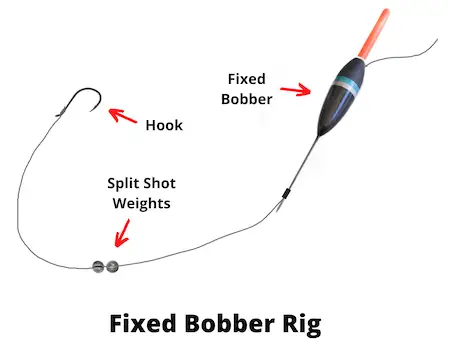
This is one of the easiest rigs to tie and use, and many anglers start their angling journey with this setup.
I remember the first time my dad took me fishing, and I used a fixed bobber and spikes to catch bluegill in a small pond.
How to tie it: This is one of the easiest rigs to tie. You start by attaching the bobber to your line. In the example shown above, there are two rubber rings that come off the bottom and the top of the bobber.
After you thread your line through these rings, you push them on to the bobber, which fixes its position on the line (though you can still move a fixed bobber up and down slowly).
Next, tie the line to your hook, add some split shot weights above the hook, and you’re done!
How to use it: Bait your hook and cast your fixed bobber rig to wherever the fish are feeding, such as the edges of weed beds in lakes, or feeding lanes in rivers or streams. Adjust the depth of your hook until you start getting bites.
When to use it: This rig is the best option when fish are feeding in shallow water under 5 feet depth. It’s great for targeting panfish or stocked trout in shallow water close to shore, or for fishing in streams and shallow rivers.
The great thing about this rig is that you can adjust the depth easily, which allows you to cover a range of depths in every location when searching for feeding fish.
Slip bobber rig

This is probably the most versatile fishing rig available for freshwater, and can be used to catch almost every species out there. In my opinion, all anglers can improve their angling game by using a slip bobber effectively.
How to tie it: Start by tying a bobber stop to your line. While you can tie your own bobber stopper knot, it’s generally easier to buy ready-made bobber stops at the tackle store, and just slide them on to your line and then tighten them down.
Next, thread a plastic bead onto your line (which prevents the bobber stopper from getting stuck in the bobber), and then thread the slip bobber on below the bead.
Next, add one or more split shot weights underneath the bobber (which prevents the bobber from sliding down onto the hook).
Then tie a bait hook on to the end of the line, and you’re done. If you’re planning to use live minnows as bait, you should add a swivel between the bobber and the hook, which prevents line twist.
How to use it: You can use the slip bobber rig with almost any kind of bait. It’s often used with live bait, or with processed bait options, such as powerbait or salmon eggs for trout fishing.
A great tactic is to use a slip bobber with a live minnow, which works well for catching a wide variety of fish, including bass, walleye, crappie, and trout.
When to use it: It’s best to use a slip bobber in water that’s deeper than about 6 feet, since it’s impractical to use a fixed bobber setup for that. If you’re trying to catch deeply suspended fish, it’s a good idea to use a fish finder in order to figure out the ideal depth range to target.
If you don’t have access to a fish finder, try to test different depths systematically with your slip bobber until you start getting bites.
Bobber and jig rig
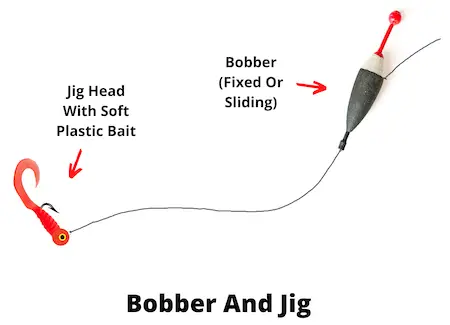
This rig was originally developed by crappie anglers, but then adopted by trout and bass anglers because it’s so effective.
How to tie it: You can use this rig with either a fixed bobber or a slip bobber, and you don’t need to use any weights, since the weight of the jig head is heavy enough on its own to get your bait to sink down to the right depth.
If you’re using braid as your main line, you may want to use a fluorocarbon leader, attached to your main line via a swivel between the hook and the bobber.
But if you’re using monofilament or fluorocarbon as your main line, you can tie that directly to the jig after rigging the bobber onto the line.
How to use it: The best way to use the bobber and jig setup is by targeting schools of fish that are suspended at a specific water depth.
Use a fish finder to determine the depth at which fish are holding, and then set the bobber to the same depth, so you can target the suspended fish with your jig.
You’ll have to experiment with how much movement you need to impart to your jig, but in my experience a small amount of movement is usually enough to trigger bites.
Try to retrieve your rig slowly, and pause the bobber regularly to allow the jig to sink down in the water, which is often when you’ll get a bite.
When to use it: This rig is a great option when you want to target crappie, trout, or bass suspended over cover, but also works well for drift fishing in rivers and streams.
How to use a bobber stopper
Bobber stops are essential for using slip bobbers, since they control the depth at which you fish, by preventing the bobber from sliding further up the line.
While you can tie your own bobber stops it’s better to buy ready-made ones from the tackle store to save you time.
You can either get string bobber stops, or bead bobber stops (also called egg stops).
The string stops are short pieces of string tied around a hollow tube, and you just insert your line into the tube, slide off the string, and pull it tight on your line.
The beads stops consist of a short wire loop, with a bead and rubber stop threaded onto the wire.
All you have to do is thread your line through the wire loop, and then slide the rubber stop and bead onto your line, before threading it through the bobber.
Do you need to use a sinker with a bobber?
Yes, in most cases you need to use a sinker with a bobber, since it weighs down your hook, and presents it at the right depth in the water.
By using a sinker with your bobber, you also make it easier for a fish to pull the bobber down when it takes the bait, resulting in fewer missed strikes.
However, if you’re targeting fish very close to the water surface, and using a weighted bobber, you may not need to use a sinker.
Also, if you’re using a jig with your bobber, you don’t need to add a sinker, since the lure has enough weight on its own.
The best sinkers to use with bobbers are split shot weights, since they can be easily added to the line by quickly pinching them, and just as easily removed again if you want to reduce the number of weights.
How far should the bobber be from the hook?
The distance between the bobber and the hook depends on the depth at which fish are feeding. If the fish are suspended at 5 feet, set the length between the bobber and hook to 5 feet.
If you don’t know exactly how deep the fish are suspended, start by setting the depth of the bobber to roughly the middle of the water column.
Then, if you don’t get any bites, try going deeper or shallower with your bobber until you start to get some bites.
Also, if you don’t know how deep the water is, slide all of your split shot weights down next to the hook, and set the depth of the bobber progressively deeper and deeper, until the bobber fails to stand up straight after you cast it out.
When this happens, you know that the split shot weights are lying on the bottom, which tells you how deep the water is at that location.
Take note of the length of line between the bobber and the hook at this depth setting, and then test different depths with your bobber using this as a point of reference.
When to use a bobber while fishing
The best time to use a bobber is when fish are suspended well above the bottom, and are therefore hard to reach with bottom fishing tactics.
This is especially true when fish are suspended above bottom cover (such as weed beds), since bobbers allow you to present your hook or lure above the top of the weeds, where it can be found by feeding fish, while the bobber prevents it from getting snagged on the weeds.
Another situation where using bobbers is a great option is when fish are feeding close to the water surface (such as trout or panfish feeding on insects at the surface).
In cases like that it’s usually best to set your depth very shallow (around 1 or 2 feet below the surface). If you set the bobber deeper than that, chances are the fish won’t notice your bait because it’s below them.
Finally, many anglers like to use bobbers simply because they enjoy this style of angling, and not only because it’s the only technique available.
For me, the thrill of watching a bobber go down when a fish takes the bait is so much fun that I just wouldn’t want to miss out on it.
Bobber fishing techniques
At its most basic level, fishing with bobbers consists of casting out a bobber with a baited hook, and waiting for a fish to bite. However, there are many variations and nuances to this basic approach, and let’s take a look at some of these here:
What is the best bait for bobber fishing?
The best bait for bobbers is either live bait, such as nightcrawlers, minnows, spikes or wax worms, or processed bait, such as salmon eggs, corn, or Berkley powerbait.
In addition to these commonly used bait options, there is a wide variety of other baits that you can try with your bobber, including marshmallows, hotdogs, cut fish strips, and many others.
Bobber fishing with artificial bait
While many anglers assume that bobbers are always used with natural bait, that’s actually far from the truth. Bobbers also work very well when combined with artificial lures, such as jigs, streamers, and flies.
There are two key advantages to using a bobber to fish an artificial lure. First of all, you can use extremely lightweight finesse lures (such as micro jigs for crappie and trout), and still cast them effectively due to the additional weight provided by the bobber.
Secondly, a bobber allows you to keep your lure above the bottom, which is the most snaggy part of any lake or river.
A great example of the latter would be when targeting crappies suspended over a weed bed. If you try to fish with a regular lure setup, your lure will likely get caught on the weeds on every single cast.
But not so if you use a bobber and set the depth correctly, since that will enable you to key in on those feeding crappie without getting snagged.
Float and fly rig
The float and fly rig is very similar to the bobber and jig setup described above, but instead of a jig head you use a hair jig as the lure. Fishing with a bobber and fly is a great finesse tactic for catching cold water bass when water temperatures drop below 50 degrees.
Since bass don’t like to move very much in cold water, you just cast out your bobber and leave it there until you get a bite.
The movement of the bobber at the water surface imparts action to the hair jig, and this is usually enough to trigger bites from bass (or crappie).
Drift fishing with a bobber
Another great way to use bobbers is for drift fishing in rivers and streams, where they can be among the best tools available for catching trout, steelhead, and salmon.
When drift fishing with a bobber, cast your rig upstream of the spot where you want to target fish, which allows your hook and sinker to get down to the strike zone before the bobber drifts past the fish.
When bobber drift fishing, it’s important to learn how to ‘mend your line’, which essentially means keeping the line between the bobber and your fishing rod above the water as much as possible, so it doesn’t affect the drifting behavior of your bobber, as this will result in a more natural bait presentation.
What types of fish can you catch with bobbers?
Since bobbers are so incredibly versatile, you can catch pretty much any freshwater fish with a bobber (as well as many saltwater fish in coastal waters). With that being said, bobbers tend to be more effective for catching some species of fish, and less so for others.
As a rule of thumb, the best kinds of fish to catch with a bobber are those that feed in water shallower than 20 or 30 feet. Much deeper than that, and it becomes hard to key in on the right depth using a bobber.
Here are the main fish species that you can readily catch with a bobber:
- Catfish
- Bass
- Crappie
- Trout
- Walleye
- Panfish
- Yellow perch
- Steelhead (in rivers)
- Salmon (in rivers)
- Northern pike
- Carp fish
Here’s a link to a great video on how to catch crappie with bobbers.
In addition to these species, you can also target muskie and lake trout with bobbers, but they are harder to catch this way, as they like to hold in deeper water.
The same is true for any other species that prefers a deep water habitat (such as kokanee salmon and whitefish), or that only feed very close to the bottom (such as burbot).
What are the best bobbers?
Now let’s take a look at a selection of the best bobbers to use for different species and fishing tactics. These are my favorite models, and I never leave the house without a few sizes of each bobber model in my tackle box.
1. Thkfish Oval Stick Float
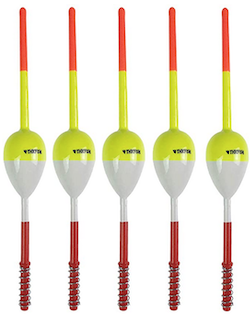
This is a great all-around bobber for small to medium sized fish in shallow water (up to about 15 feet).
Made of balsa wood, it’s more sensitive than plastic bobbers, and comes with a spring mechanism at the bottom that can be used to attach your line (either as a fixed bobber or sliding bobber).
Best for:
- Trout
- Crappie
- Panfish
2. Free Fisher Slip Bobber
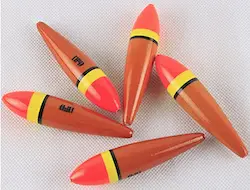
This is my go-to choice of slip bobber, since the oval teardrop shape reduces resistance in the water, making this oval bobber shape ideal for pressured fish that let go quickly of your bait if they feel too much resistance.
Made of balsa, this slip bobber comes in a size that’s ideal for medium sized fish.
Best for:
- Bass
- Trout
- Crappie
- Walleye
- Steelhead
3. Lindy Thill Wobble Bobber
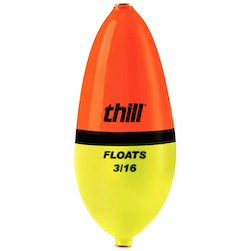
This is a great bobber for shore fishing, since you can easily cast this oval egg shaped bobber a country mile with your rod, which helps to cover a lot of water from shore.
Also, even if you’re casting from a boat, the Thill Wobble Bobber can help if you want to target skittery fish on shallow structure that would get spooked if you fish too close to them.
Best for:
- Bass
- Trout
- Crappie
- Walleye
- Steelhead
4. XFishman Pencil Float
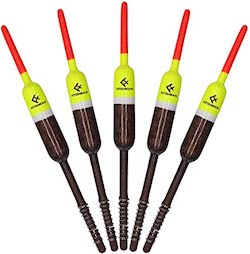
These balsa pencil floats are great if you’re dealing with a shy bite from pressured fish. Due to the pencil shape, the float offers very little resistance when a fish takes the bait.
The elongated shape also makes these pencil bobbers good for detecting negative bites (i.e. when the fish swims up with the hook in its mouth), which is quite common with perch and panfish. When that happens, you’ll notice the pencil float go up in the water, before lying down flat on the water.
Best for:
- Crappie
- Bluegill
- Panfish
- Yellow perch
5. Rainbow Bubble Float
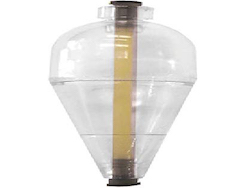
The round Rainbow bubble float is transparent, which provides maximum stealth when targeting finicky fish in shallow, clear water. Ideal for trout and bass in creeks, as well as pressured crappie and panfish in shallow water.
Another advantage of the Rainbow bubble float is that you can add water to the round plastic bubble to increase casting distance, which comes in handy when fishing with lightweight micro lures.
Best for:
- Trout
- Crappie
- Bass
- Panfish
Conclusion
This wraps up our ultimate guide on how to fish with a bobber. While non-anglers often assume that bobbers and corks are only used by beginners or kids fishing in small ponds, this is actually far from the truth, as many seasoned anglers regularly use bobbers to catch trophy size fish.
This makes perfect sense, given that bobbers allow you to present your bait or lure directly over dense cover (which is often unfishable with other fishing techniques), and this is just one of their key advantages.
So make sure to leverage the power of bobbers to become a better angler, and let us know how it goes. Tight lines and see you on the water!
